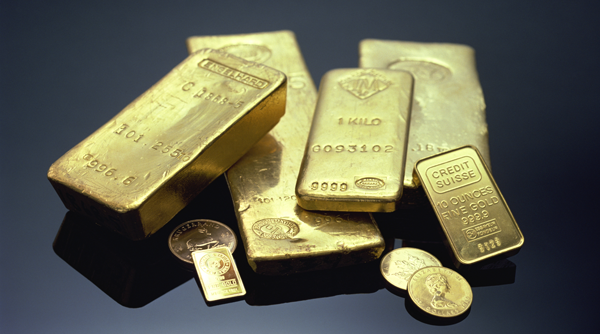Money is piling into gold amid concerns over the U.S. economy that could slow the Federal Reserve’s plans to raise interest rates. Adding fuel to the rally are growing U.S.-North Korea tensions. Last week, investors poured $1 billion into the largest exchange-traded fund backed by bullion, the most since mid-2016. That helped gold close above $1,300 an ounce for the first time this year.
ETF buyers are building their holdings, joining hedge funds that have boosted their net-long position in bullion futures by almost nine-fold since early July. Through Tuesday, assets in gold-backed ETFs tracked by Bloomberg posted the biggest three-day gain since February.
“If gold is really ‘the sum of all fears,’ then the gold price is saying that not all is rosy in the garden,” Ross Norman, the chief executive officer of London-based precious metals dealer Sharps Pixley Ltd., said in a note Wednesday. “Gold seems to have momentum behind it, too.”
Gold for immediate delivery slipped 0.4 percent to $1,334.09 an ounce at 2:03 p.m. in New York, after rising for four straight sessions, according to Bloomberg generic pricing. On Tuesday, prices climbed as much as 0.8 percent to $1,344.44, the highest since Sept. 8, 2016. Gold futures for December delivery fell 0.4 percent to settle at $1,339 an ounce on the Comex.
The price of SPDR Gold Shares, the biggest bullion-backed ETF, is up more than 7 percent this quarter.
The odds of another rate increase in the U.S. by the end of this year have slipped to about 29 percent from 40 percent a month earlier amid doubts on central bankers’ resolve to tighten monetary policy.
On Wednesday, the central bank’s Beige Book report, based on anecdotal information collected by the 12 regional Fed banks from early July through August, showed the majority of districts reported “ limited wage pressures and modest to moderate wage growth.”
‘Real Harm’
The Beige Book came a day after Federal Reserve Governor Lael Brainard said the U.S. central bank needs to pay careful attention to underlying inflation before raising rates again, as longer-run price pressure trends appear to be lower. The “sum of all fears” has restored investors’ faith in gold.
The “sum of all fears” has restored investors’ faith in gold.
‘Sum Of All Fears’ Fuels Gold Rally As SPDR Attracts $1 Billion
September 6, 2017
« Previous Article
| Next Article »
Login in order to post a comment
Comments
-
"The price of SPDR Gold Shares, the biggest bullion-backed ETF" This is highly questionable. Paper gold GLD claims to be fully backed by physical gold bullion but yet it refuses to give retail investors the right to redeem for any of these ‘claimed’ gold bullion. This fact alone would mean GLD shares are nothing more than paper at the end of the day. Furthermore, GLD’s prospectus is chalk full of weasel clauses and legal loopholes that allows the fund to get away without the full physical gold backing. One good example of this is the clause that states GLD has no right to audit subcustodial gold holdings. To this day, I have not heard of a single good reason for the existence of this audit loophole. I’ve also verified the following to be true and welcome everyone else to do so: "Did anyone try calling the GLD hotline at (866) 320 4053 in search of numerical details on GLD's insurance? The prospectus vaguely states "The Custodian maintains insurance with regard to its business on such terms and conditions as it considers appropriate which does not cover the full amount of gold held in custody." When I asked about how much of the gold was insured, the representative proceeded to act as if he didn't know and said they were just the "marketing agent" for GLD. What kind of marketing agent would not know such basic information about a product they are marketing? It seems like they are deliberately hiding information from investors." "I remember there was a well documented visit by CNBC's Bob Pisani to GLD's gold vault. This visit was organized by GLD's management to prove the existence of GLD's gold but the gold bar held up by Mr. Pisani had the serial number ZJ6752 which did not appear on the most recent bar list at that time. It was later discovered that this "GLD" bar was actually owned by ETF Securities."








